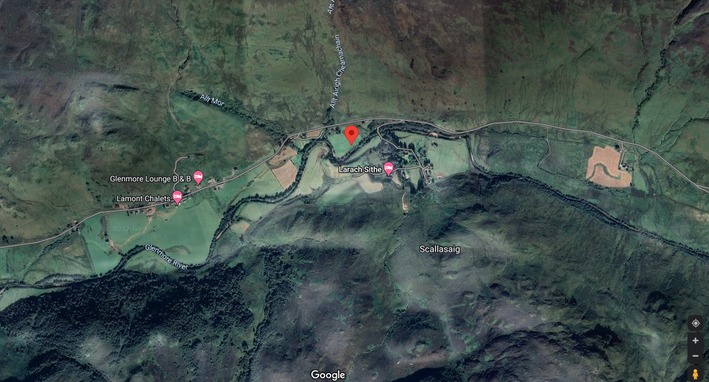Its precise location is unknown. And its surviving folklore came from another resident of London's Cheyne Row. Thu 28 April 2022
Likely location of Glenelg's alleged serpent mound. Source: Google Maps)
Believed to be at: (Google Maps), (Google Streetview), (OpenStreetMap), (NLS), (Flickr images) per Paul Bennett.
From: The Peat-Fire Flame: Folk-Tales and Traditions of the Highlands and Islands, Alisdair Alpin MacGregor, Ettrick Press: Edinburgh 1937, p86, via The Northern Antiquarian:
This place was, said MacGregor, a site: where the people in olden times used to worship the serpent.
MacGregor spoke with a local man about the myths here and asked how long it had been associated with serpents.
Och, about two thousand years, said Mr John MacRae. The mound was in the shape of a serpent, and when the chief of the people would die, he would be buried in the head of the serpent..
He continued, saying:
One from London, that was going about searching things like that, opened the mound, and they found in the mound a big stone coffin with a big stone slab on the top. And there the bowl was found with the ashes of the chief of the people at that time. The bowl was taken to the Manse. That’s about fifty years ago. It was there for a few months; and they took it to Edinburgh, to some museum or something. They were saying that there was a funny noise in the Manse when the bowl was lying there. If there was any treasure in the bowl, or in the grave along with the bowl, it was taken out before. You see, had he any treasure – the chief like – guns and money and the like – I’m sure they wouldn’t be putting much money in the grave. It would be going into the grave with the dead man, so, when he would rise in the next world, he would be ready to start at the same game as he was carrying on here on Earth.
Glenelg serpent mound was described by The Northern Antiquarian (unavailable as of 2022-11-11) and referenced by Northern Earth.
Several oddities come with the Glenelg Serpent Mound story:
- There is no first hand account - or image - of Glenelg Serpent Mound.
- Google's satellite image shows no trace of the serpent (though that is not unusual).
- Alisdair Alpin MacGregor lived at 14 Paulson's Square, Chelsea at the time he published The Peat-Fire Flame: Folk-Tales and Traditions of the Highlands and Islands. That puts his house a minute or so's walk away from Cheyne Row and Cheyne Walk. 19th century residents of Cheyne Row and Cheyne Walk seem to have been involved in the cleansing of Britain's old culture and replacing it with modern folklore.
© All rights reserved. The original author retains ownership and rights.
More of this investigation:
Serpent Mounds
More by tag:
#mounds, #Cheyne Row
